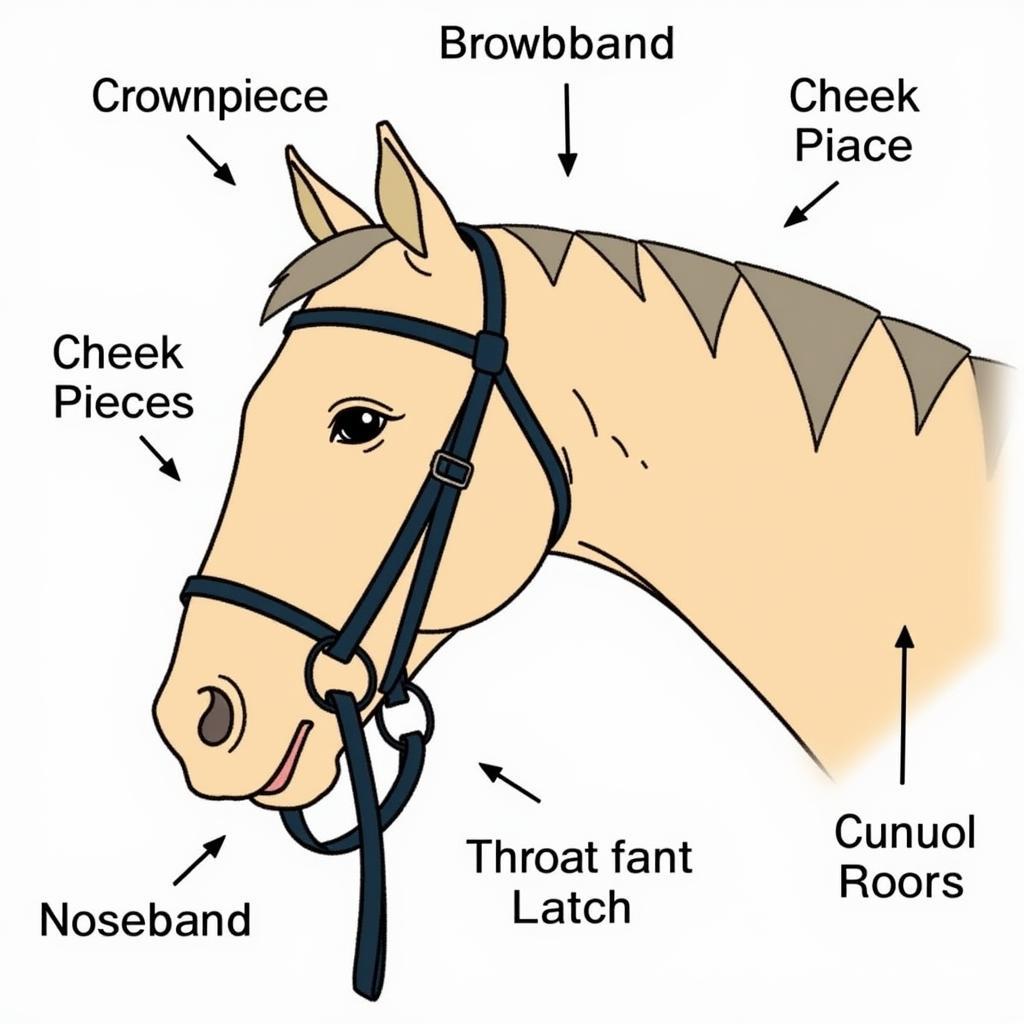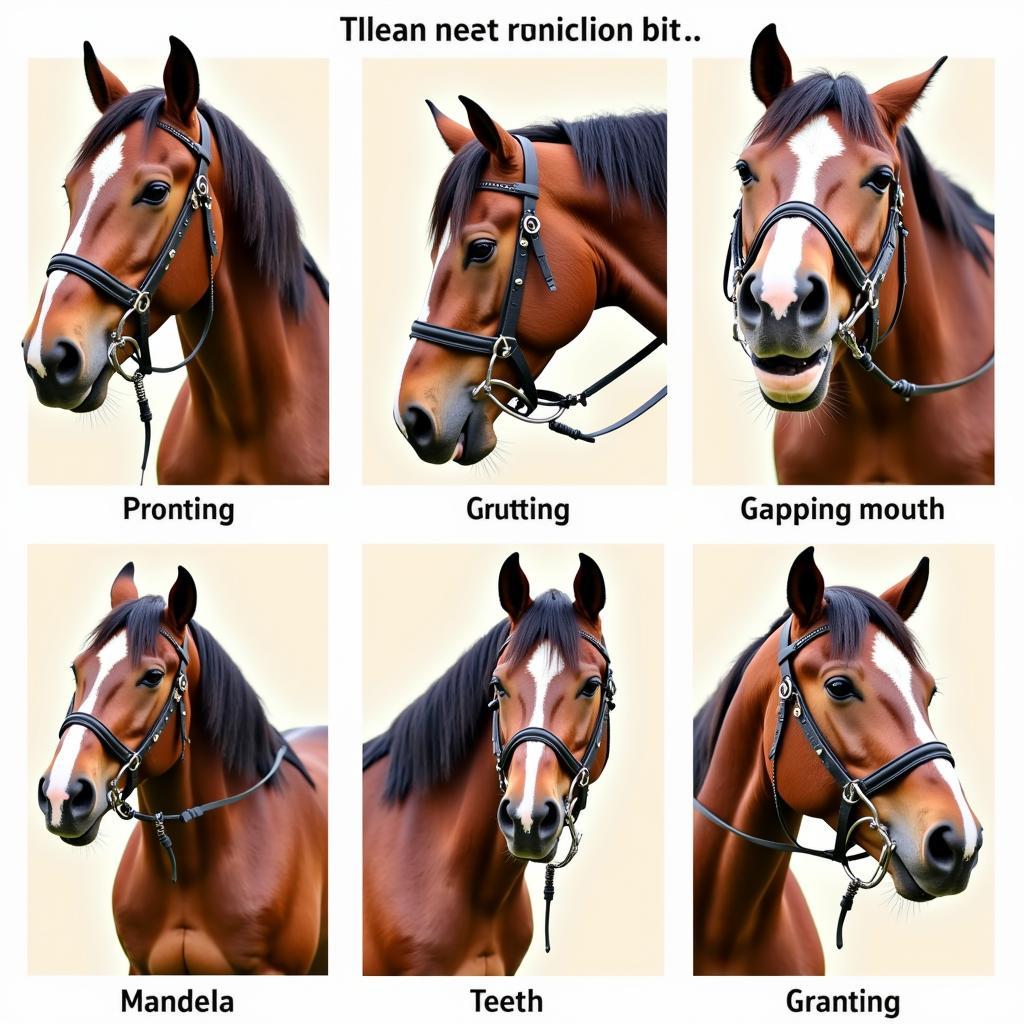Understanding the intricacies of horse tack can feel overwhelming, especially for new horse owners. Two pieces of equipment essential to riding and communication are Horse Bridles And Bits. Choosing the right ones, however, requires a solid understanding of their purpose, different types, and how they impact your horse’s comfort and performance. This guide explores the nuances of horse bridles and bits, equipping you with the knowledge to make informed decisions for your equine partner.
Bridles: The Foundation of Control
 Horse Bridle Parts
Horse Bridle Parts
A bridle is much more than just headgear for your horse. It acts as the primary point of contact, allowing for communication and control while riding. Composed of various parts, each element of the bridle plays a crucial role:
- Crownpiece: This strap fits over the horse’s poll (behind the ears) and distributes pressure evenly to prevent discomfort.
- Cheek Pieces: These straps connect the crownpiece to the bit and can be adjusted to ensure the bit sits correctly in the horse’s mouth.
- Browband: Primarily decorative, the browband helps keep the crownpiece from slipping behind the horse’s ears.
- Throat Latch: This adjustable strap prevents the bridle from being pulled over the horse’s ears.
- Noseband: Different types of nosebands exist, each serving a purpose, from providing stability to preventing the horse from opening its mouth too wide.
- Reins: Attached to the bit, the reins are the rider’s primary means of communicating with the horse, applying pressure and directing movement.
Selecting the right bridle depends on the horse’s discipline and head shape. Common types include English bridles, often seen in English riding disciplines like dressage and show jumping, and Western bridles, frequently used for Western riding styles such as reining and barrel racing.
Bits: Communication Tools
 Types of Horse Bits
Types of Horse Bits
Often considered the most controversial aspect of horse tack, bits reside inside the horse’s mouth and work in conjunction with the bridle to facilitate communication between horse and rider. They apply pressure to the tongue, bars (the space between the teeth and molars), and lips, prompting specific responses from the horse.
Choosing the appropriate bit for your horse is crucial and depends on various factors, including:
- Horse’s Age and Experience: Younger or less experienced horses typically start with milder bits, such as snaffle bits.
- Discipline: Certain disciplines, like dressage, have specific rules regarding permissible bits.
- Horse’s Mouth Conformation: Horses have unique mouth shapes, and a bit that suits one horse may not be suitable for another.
Common types of bits include:
- Snaffle Bits: Generally considered milder, snaffle bits work with direct pressure and are commonly used for training. They can be further categorized into loose ring, eggbutt, and D-ring snaffles, each offering subtle differences in action. You can find a variety of horse bits for sale, including snaffles, from reputable online retailers.
- Curb Bits: These bits use leverage for increased control and are typically used with a curb chain. They are often seen in Western riding disciplines and require more experience from both horse and rider.
- Pelham Bits: A combination of snaffle and curb action, Pelham bits offer versatility. They utilize a single mouthpiece with two sets of reins or a single rein with a converter.
Choosing the Right Fit
Selecting appropriate horse bridles and bits is crucial for the horse’s comfort and well-being. Consider these factors when making your selection:
- Fit: The bridle should fit snugly without being too tight. Adjustability in the cheek pieces and throat latch is crucial for achieving the perfect fit.
- Bit Size: An improperly fitting bit can cause discomfort, pain, and even injury. Seek professional assistance from an experienced equestrian or equine dentist to determine the correct bit size for your horse.
- Material: Bridles and bits are available in various materials, including leather, synthetic materials, and metal alloys. Consider your budget, care preferences, and the horse’s sensitivities when making a choice.
Signs of a Problem
 Signs of Bitting Problems in Horses
Signs of Bitting Problems in Horses
Horses are masters at hiding discomfort, so it’s crucial to be vigilant for signs of potential bitting problems, such as:
- Head Tossing: Excessive head tossing while riding can be a sign of discomfort related to the bit.
- Gaping Mouth: A horse that constantly opens its mouth or tries to evade the bit may be experiencing pain or pressure.
- Teeth Grinding: This behavior can indicate stress or discomfort, potentially caused by an ill-fitting bit.
- Reluctance to Go Forward: A sudden unwillingness to move forward or difficulty turning could be related to bit-related pain.
If you observe any of these signs, it’s essential to consult with an equine professional, such as a veterinarian or experienced trainer, to assess the situation and determine the best course of action. They can help identify the root cause of the problem and recommend alternative bitting options or adjustments to your current setup.
Conclusion
Choosing the right horse bridles and bits is a fundamental aspect of responsible horsemanship. By understanding the different types, considering your horse’s individual needs, and seeking professional guidance when necessary, you can ensure your horse’s comfort, well-being, and optimal performance. For those interested in exploring different options, you can find a variety of used horse bits for sale, offering a budget-friendly way to experiment with different bitting solutions. Remember, a comfortable and well-bitted horse is a happy horse!
FAQs
1. How do I know if a bit fits my horse correctly?
A properly fitted bit should lie comfortably in the horse’s mouth without pinching or pulling at the corners. As a general rule, there should be approximately 1/4 to 1/2 inch of space between the bit rings and the horse’s mouth on either side.
2. My horse seems uncomfortable in a snaffle bit. What are my other options?
There are many different types of snaffle bits available, including loose ring, eggbutt, and D-ring snaffles, each offering subtle differences in action. It’s essential to consult with an experienced equestrian or equine dentist to determine which type of snaffle might be most comfortable for your horse.
3. Can I use a curb bit on a young or inexperienced horse?
Curb bits are generally not recommended for young or inexperienced horses due to their increased leverage action. Starting with a milder bit, like a snaffle, allows the horse to learn basic cues and develop proper mouth sensitivity before transitioning to a more advanced bit, if necessary.
4. How often should I clean my horse’s bit?
Cleaning your horse’s bit regularly is crucial for maintaining hygiene and preventing the buildup of dirt, grime, and bacteria. It’s a good practice to rinse the bit after each ride and give it a thorough cleaning with warm, soapy water at least once a week.
5. Where can I learn more about different types of horse bridles and bits?
Reputable online resources like Justus Horses USA offer a wealth of information on horse tack and equipment, including comprehensive guides on horse bridles and bits. You can also find valuable insights from experienced equestrians, trainers, and equine dentists.
For any further questions or concerns about horse bridles and bits, don’t hesitate to contact us at:
Phone Number: 0772127271
Email: [email protected]
Address: QGM2+WX2, Vị Trung, Vị Thuỷ, Hậu Giang, Việt Nam.
Our dedicated customer support team is available 24/7 to assist you.